The erbium-169 market is projected to expand from USD 2.0 million in 2025 to USD 4.4 million by 2035, reflecting a CAGR of 8.1%. Growth in the erbium-169 is shaped not only by rising adoption in healthcare and nuclear medicine but also by the way companies manage their position in the value chain. Integration strategies, whether backward, forward, or horizontal, determine competitiveness, cost efficiency, and market resilience. Erbium-169, a rare isotope derived from the rare earth element erbium, finds critical use in radiation synovectomy treatments, targeted therapy research, and niche specialty chemical applications. The ability to integrate across supply stages has emerged as a central factor in balancing supply security with innovation.
Backward integration into feedstocks is crucial due to the supply chain challenges associated with rare earth elements. Erbium is typically mined as part of monazite or xenotime deposits, with major reserves concentrated in China, Russia, and select African countries. Companies seeking greater security of supply are exploring direct partnerships with mining operators and investing in refining infrastructure to reduce dependency on volatile international markets. Control over upstream resources enables stable isotope production, thereby mitigating risks associated with geopolitical tensions, export restrictions, and price spikes. For medical isotope producers, backward integration ensures reliability of isotope availability, a necessity for hospitals and research labs that rely on consistent dosage scheduling.
Forward integration into specialty chemicals and end-use applications is equally important. Producers of erbium-169 are increasingly moving beyond isotope production into formulating end-use products, such as radiation synovectomy kits, sealed sources, and diagnostic-grade compounds. By engaging directly with the healthcare sector, isotope producers capture more value downstream and position themselves closer to demand centers. Integration into specialty formulations also supports higher margins, as customers prioritize quality assurance, safety certification, and regulatory compliance in sensitive medical environments. Forward integration into adjacent markets such as optoelectronic materials, laser systems, and photonics compounds is also under consideration, diversifying reliance away from solely medical uses.
Horizontal integration across product categories provides another growth avenue. Companies involved in rare earth isotopes are exploring multi-isotope portfolios, offering erbium-169 alongside lutetium-177, holmium-166, or yttrium-90 to meet broader therapeutic and research needs. This diversification spreads risk, supports economies of scope, and strengthens long-term customer relationships with hospitals and research centers. Horizontal expansion into other rare earth specialty chemicals, such as erbium-doped fiber amplifiers for telecom or laser-grade oxides, can also complement isotope businesses by sharing extraction, purification, and processing infrastructure. The overall value chain for erbium-169 remains sensitive due to resource concentration and processing complexity. Companies that achieve balanced integration, securing feedstocks upstream, building specialty product capabilities downstream, and expanding horizontally into related isotopes and chemicals, are best positioned to capture steady growth. With healthcare applications expanding and innovation in rare earth processing advancing, strategic integration will remain a key driver of competitiveness in the erbium-169 market through 2035.
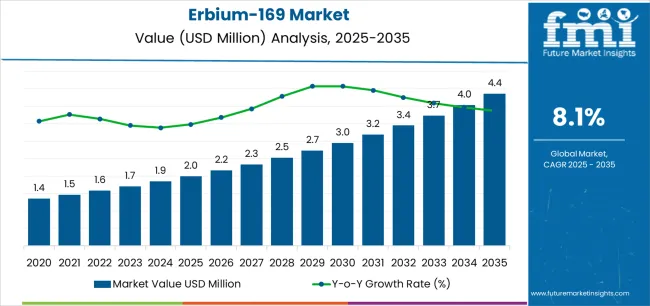
| Period | Primary Revenue Buckets | Share | Notes |
|---|---|---|---|
| Today | Reactor production systems | 55% | Traditional production, medical isotopes |
| Nuclear medicine applications | 32% | Therapeutic formulations, diagnostic applications | |
| Accelerator production | 8% | Advanced production methods | |
| Scientific research services | 5% | Laboratory applications, research support | |
| Future (3-5 yrs) | Advanced reactor systems | 50-52% | Enhanced production efficiency, automated systems |
| Therapeutic monitoring & analytics | 22-25% | Real-time tracking, patient outcomes | |
| Accelerator production expansion | 12-15% | Advanced cyclotron systems, precision production | |
| Industrial tracer applications | 8-11% | Quality control, process monitoring | |
| Digital integration services | 3-6% | Connected systems, data analytics | |
| Research & development services | 2-4% | Clinical trials, regulatory support |
The market demonstrates strong fundamentals with reactor production systems capturing a dominant share through advanced isotope production capabilities and nuclear medicine application optimization. Nuclear medicine applications drive primary demand, supported by increasing therapeutic requirements and healthcare facility capacity expansion. Geographic expansion remains concentrated in developed markets with established nuclear infrastructure, while emerging economies show accelerating adoption rates driven by nuclear medicine modernization initiatives and rising quality standards.
At-a-Glance Metrics
| Metric | Value |
|---|---|
| Market Value (2025) | USD 2.0 million |
| Market Forecast (2035) | USD 4.5 million |
| Growth Rate | 8.1% CAGR |
| Leading Technology | Reactor Production Systems |
| Primary Application | Nuclear Medicine Segment |
Primary Classification: The market segments by production type into reactor production, accelerator production, and hybrid production systems, representing the evolution from basic isotope manufacturing to sophisticated nuclear medicine solutions for comprehensive healthcare optimization.
Secondary Classification: Application segmentation divides the market into nuclear medicine, industrial tracer applications, and scientific research, reflecting distinct requirements for therapeutic effectiveness, safety standards, and clinical outcomes.
Tertiary Classification: End-use segmentation covers hospitals, research institutions, radiopharmaceutical companies, nuclear medicine clinics, and industrial facilities, while distribution channels span direct sales, nuclear medicine distributors, and specialized suppliers.
Regional Classification: Geographic distribution covers North America, Latin America, Western Europe, Eastern Europe, East Asia, South Asia Pacific, and Middle East & Africa, with developed markets leading adoption while emerging economies show accelerating growth patterns driven by nuclear infrastructure expansion programs.
The segmentation structure reveals technology progression from standard isotope production toward sophisticated nuclear medicine systems with enhanced safety and efficacy capabilities, while application diversity spans from hospital facilities to industrial operations requiring precise isotope solutions.
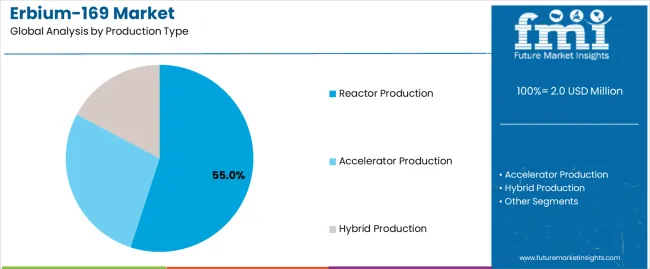
Market Position: Reactor Production systems command the leading position in the Erbium-169 market with 55% market share through advanced isotope production features, including superior neutron flux utilization, safety characteristics, and nuclear medicine application optimization that enable facilities to achieve optimal therapeutic outcomes across diverse medical and research environments.
Value Drivers: The segment benefits from facility preference for reliable production systems that provide consistent isotope quality, reduced production time, and operational efficiency optimization without requiring significant infrastructure modifications. Advanced reactor features enable automated production control systems, safety monitoring, and integration with existing nuclear facilities, where production performance and radiation safety represent critical facility requirements.
Competitive Advantages: Reactor Production systems differentiate through proven isotope reliability, consistent production characteristics, and integration with automated nuclear systems that enhance facility effectiveness while maintaining optimal safety standards suitable for diverse medical and research applications.
Key market characteristics:
Accelerator Production systems maintain an 8% market position in the Erbium-169 market due to their precision capabilities and advanced technology advantages. These systems appeal to facilities requiring high-purity isotope solutions with competitive production profiles for specialized nuclear medicine applications. Market growth is driven by cyclotron technology expansion, emphasizing precision production solutions and operational effectiveness through optimized accelerator designs.
Hybrid Production systems capture emerging market share through specialized applications combining reactor and accelerator technologies, advanced research facilities, and specialized production requirements. These facilities demand versatile production systems capable of handling multiple production methods while providing effective isotope capabilities and operational reliability.
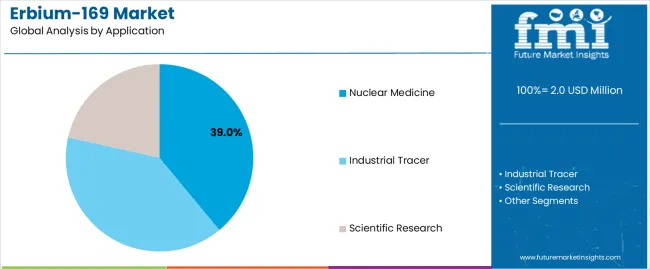
Market Context: Nuclear medicine applications show the highest growth in the Erbium-169 market with a 9.2% CAGR and a 39% industry share, driven by the widespread adoption of therapeutic isotopes and an increasing focus on targeted therapy optimization, operational cost efficiency, and patient outcome initiatives that enhance therapeutic effectiveness while maintaining safety standards.
Appeal Factors: Nuclear medicine operators prioritize isotope reliability, therapeutic consistency, and integration with existing healthcare infrastructure that enables coordinated treatment operations across multiple therapy sessions. The segment benefits from substantial healthcare investment and modernization programs that emphasize the acquisition of advanced isotope systems for treatment optimization and patient care applications.
Growth Drivers: Healthcare expansion programs incorporate nuclear medicine isotopes as standard materials for therapeutic operations, while aging population growth increases demand for targeted therapy capabilities that comply with safety standards and minimize treatment complexity.
Market Challenges: Varying patient requirements and treatment protocol complexity may limit isotope standardization across different facilities or therapy scenarios.
Application dynamics include:
Industrial Tracer applications capture 20% market share through specialized quality control requirements in manufacturing facilities, process monitoring centers, and industrial applications. These facilities demand effective tracer systems capable of supporting quality assurance processes while providing reliable monitoring access and operational capabilities.
Scientific Research applications account for 15% market share, including research institutions, laboratory operations, and academic facilities requiring specialized isotope capabilities for research optimization and scientific advancement.
Market Context: Research Institutions dominate the market with 9.5% CAGR, reflecting the primary demand source for Erbium-169 technology in scientific applications and nuclear research operations.
Business Model Advantages: Research institutions provide direct market demand for advanced isotope materials, driving product innovation and capacity expansion while maintaining quality control and regulatory compliance requirements.
Operational Benefits: Research applications include scientific studies, nuclear research, and quality assurance that drive consistent demand for isotope products while providing access to latest nuclear technologies.
| Category | Factor | Impact | Why It Matters |
|---|---|---|---|
| Driver | Aging population & targeted therapy demand (precision medicine, therapeutic applications) | ★★★★★ | Growing elderly population requires consistent therapeutic isotope solutions with proven safety and efficacy across treatment applications. |
| Driver | Nuclear medicine infrastructure expansion & modernization (emerging markets) | ★★★★★ | Turns advanced isotope systems from "optional" to "mandatory"; providers that offer technical support and safety documentation gain competitive advantage. |
| Driver | Research & development growth & scientific advancement (nuclear physics, medical research) | ★★★★☆ | Research institutions need reliable, high-purity systems; demand for specialized and research-grade isotope solutions expanding addressable market. |
| Restraint | Regulatory compliance & safety validation costs (especially for new production methods) | ★★★★☆ | Smaller research facilities defer purchases; increases price sensitivity and slows advanced isotope adoption in cost-conscious markets. |
| Restraint | Alternative isotope competition (other lanthanides, synthetic alternatives) | ★★★☆☆ | Alternative isotopes offer different properties and applications, potentially limiting Erbium-169 adoption in certain therapeutic applications. |
| Trend | Advanced production integration & monitoring (automation, quality control) | ★★★★★ | Real-time production monitoring, quality tracking, and isotope analytics transform operations; automation and digital integration become core value propositions. |
| Trend | Personalized medicine & targeted formulations (patient-specific needs) | ★★★★☆ | Custom isotope preparations for specific conditions; specialized products and targeted therapeutic capabilities drive competition toward personalization solutions. |
The Erbium-169 market demonstrates varied regional dynamics with Growth Leaders including China (10.9% growth rate) and India (10.1% growth rate) driving expansion through nuclear medicine modernization initiatives and isotope production capacity development.
Steady Performers encompass Germany (9.3% growth rate), Brazil (8.5% growth rate), and developed regions, benefiting from established nuclear industries and advanced isotope production adoption. Mature Markets feature United States (7.7% growth rate), United Kingdom (6.9% growth rate), and Japan (6.1% growth rate), where nuclear technology advancement and regulatory standardization requirements support consistent growth patterns.
Regional synthesis reveals Asian markets leading adoption through nuclear infrastructure expansion and production capacity development, while North American countries maintain steady expansion supported by nuclear medicine technology advancement and clinical standardization requirements. European markets show moderate growth driven by nuclear applications and quality integration trends.
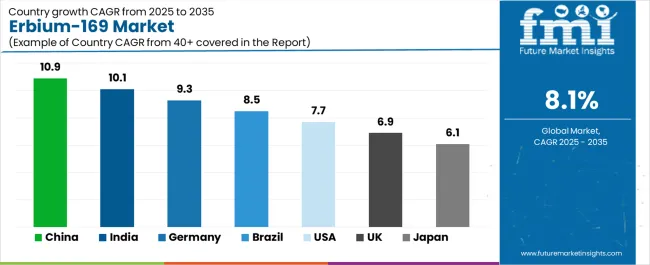
| Region/Country | 2025 to 2035 Growth | How to win | What to watch out |
|---|---|---|---|
| China | 10.9% | Focus on nuclear infrastructure solutions | Regulatory changes; local competition |
| India | 10.1% | Lead with cost-effective production systems | Import restrictions; price sensitivity |
| Germany | 9.3% | Provide premium quality isotopes | Over-regulation; lengthy approvals |
| Brazil | 8.5% | Offer value-oriented models | Currency fluctuations; import duties |
| United States | 7.7% | Push technology integration | NRC compliance costs; regulatory issues |
| United Kingdom | 6.9% | Focus on research compatibility | Brexit impacts; budget constraints |
| Japan | 6.1% | Emphasize precision systems | Aging infrastructure; slow adoption |
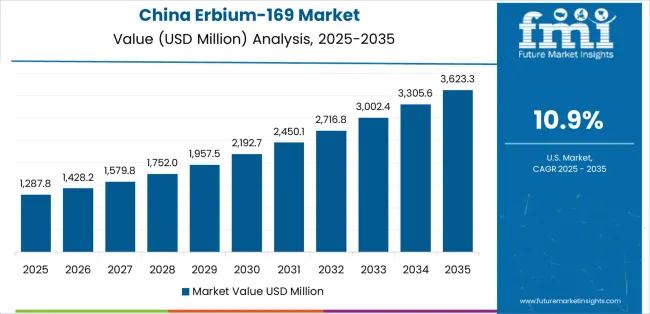
China establishes fastest market growth through aggressive nuclear medicine modernization programs and comprehensive isotope production capacity development, integrating advanced Erbium-169 systems as standard components in nuclear medicine facilities and research installations. The country's 10.9% growth rate reflects government initiatives promoting nuclear infrastructure and domestic isotope production capabilities that mandate the use of advanced production systems in medical and research facilities. Growth concentrates in major nuclear centers, including Beijing, Shanghai, and Guangzhou, where nuclear technology development showcases integrated production systems that appeal to operators seeking advanced treatment optimization capabilities and research applications.
Chinese manufacturers are developing cost-effective isotope production solutions that combine domestic production advantages with advanced nuclear features, including automated quality control and enhanced safety capabilities. Distribution channels through nuclear equipment suppliers and medical distributors expand market access, while government support for nuclear medicine modernization supports adoption across diverse medical and research segments.
Strategic Market Indicators:
In Delhi, Mumbai, and Bangalore, nuclear medicine facilities and research centers are implementing advanced Erbium-169 systems as standard materials for therapeutic optimization and research applications, driven by increasing government nuclear investment and infrastructure modernization programs that emphasize the importance of isotope production capabilities. The market holds a 10.1% growth rate, supported by government nuclear initiatives and infrastructure development programs that promote advanced isotope systems for medical and research facilities. Indian operators are adopting production systems that provide consistent isotope quality and safety features, particularly appealing in urban regions where treatment effectiveness and research outcomes represent critical operational requirements.
Market expansion benefits from growing nuclear capabilities and international technology partnerships that enable domestic production of advanced isotope systems for medical and research applications. Technology adoption follows patterns established in nuclear equipment, where reliability and performance drive procurement decisions and operational deployment.
Market Intelligence Brief:
Germany's advanced nuclear technology market demonstrates sophisticated Erbium-169 deployment with documented therapeutic effectiveness in nuclear medicine applications and research facilities through integration with existing patient care systems and nuclear infrastructure. The country leverages engineering expertise in nuclear technology and quality systems integration to maintain a 9.3% growth rate. Nuclear centers, including Baden-Württemberg, Bavaria, and North Rhine-Westphalia, showcase premium installations where isotope systems integrate with comprehensive nuclear medicine platforms and facility management systems to optimize treatment operations and research effectiveness.
German manufacturers prioritize system precision and EU compliance in nuclear equipment development, creating demand for premium systems with advanced features, including facility monitoring integration and automated safety systems. The market benefits from established nuclear technology infrastructure and a willingness to invest in advanced isotope technologies that provide long-term operational benefits and compliance with international nuclear standards.
Market Intelligence Brief:
Brazil's market expansion benefits from diverse nuclear demand, including infrastructure modernization in São Paulo and Rio de Janeiro, nuclear facility upgrades, and government nuclear programs that increasingly incorporate isotope solutions for medical applications. The country maintains an 8.5% growth rate, driven by rising nuclear activity and increasing recognition of isotope technology benefits, including precise production control and enhanced therapeutic effectiveness.
Market dynamics focus on cost-effective isotope solutions that balance advanced nuclear performance with affordability considerations important to Brazilian nuclear operators. Growing nuclear industrialization creates continued demand for modern isotope systems in new facility infrastructure and nuclear modernization projects.
Strategic Market Considerations:
United States establishes market leadership through comprehensive nuclear medicine programs and advanced nuclear infrastructure development, integrating Erbium-169 systems across hospital and research applications. The country's 7.7% growth rate reflects established nuclear industry relationships and mature isotope technology adoption that supports widespread use of precision isotope systems in medical and research facilities. Growth concentrates in major nuclear centers, including California, Texas, and New York, where nuclear technology showcases mature isotope deployment that appeals to operators seeking proven therapeutic capabilities and operational efficiency applications.
American nuclear providers leverage established distribution networks and comprehensive technical support capabilities, including validation programs and training support that create customer relationships and operational advantages. The market benefits from mature regulatory standards and nuclear requirements that mandate isotope system use while supporting technology advancement and operational optimization.
Market Intelligence Brief:
United Kingdom's nuclear market demonstrates integrated Erbium-169 deployment with documented clinical effectiveness in NHS applications and private research facilities through integration with existing nuclear medicine systems and research infrastructure. The country maintains a 6.9% growth rate, supported by nuclear modernization programs and clinical effectiveness requirements that promote advanced isotope systems for medical applications. Nuclear facilities across England, Scotland, and Wales showcase systematic installations where isotope systems integrate with comprehensive nuclear medicine platforms to optimize treatment operations and research outcomes.
UK nuclear providers prioritize system reliability and regulatory compatibility in isotope procurement, creating demand for validated systems with proven nuclear features, including monitoring integration and automated safety systems. The market benefits from established nuclear infrastructure and clinical validation requirements that support isotope technology adoption and operational effectiveness.
Market Intelligence Brief:
Japan's market growth benefits from precision nuclear demand, including advanced nuclear facilities in Tokyo and Osaka, nuclear technology integration, and research programs that increasingly incorporate isotope solutions for scientific applications. The country maintains a 6.1% growth rate, driven by nuclear technology advancement and increasing recognition of precision isotope benefits, including accurate production control and enhanced research outcomes.
Market dynamics focus on high-precision isotope solutions that meet Japanese quality standards and research effectiveness requirements important to nuclear operators. Advanced nuclear technology adoption creates continued demand for sophisticated isotope systems in research facility infrastructure and nuclear modernization projects.
Strategic Market Considerations:
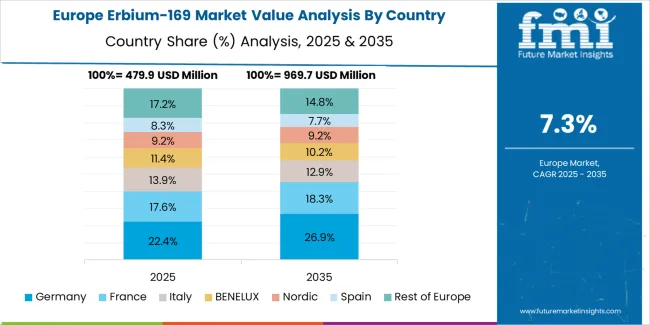
The European Erbium-169 market is projected to grow from USD 0.52 million in 2025 to USD 1.18 million by 2035, registering a CAGR of 8.5% over the forecast period. Germany is expected to maintain its leadership position with a 41.3% market share in 2025, supported by its advanced nuclear technology infrastructure and major research centers.
United Kingdom follows with a 26.9% share in 2025, driven by comprehensive nuclear medicine programs and research technology development initiatives. France holds a 14.4% share through specialized nuclear applications and regulatory compliance requirements. Italy commands a 9.6% share, while Spain accounts for 7.8% in 2025. The rest of Europe region is anticipated to gain momentum, expanding its collective share from 4.8% to 5.1% by 2035, attributed to increasing nuclear adoption in Nordic countries and emerging research facilities implementing nuclear modernization programs.
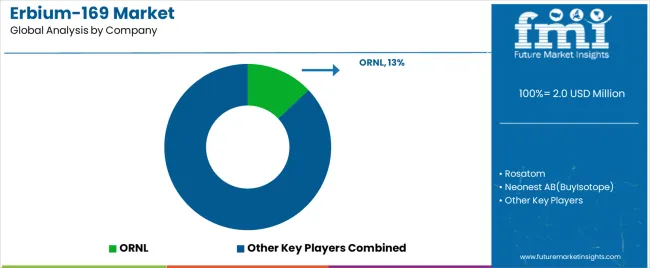
| Stakeholder | What they actually control | Typical strengths | Typical blind spots |
|---|---|---|---|
| Global platforms | Distribution reach, broad product catalogs, technical support networks | Wide availability, proven safety, multi-region support | Product refresh cycles; customer dependency on technical validation |
| Production innovators | R&D capabilities; advanced isotope production; clean safety profiles | Latest production methods first; attractive ROI on nuclear effectiveness | Service density outside core regions; customization complexity |
| Regional specialists | Local compliance, fast delivery, nearby technical support | "Close to site" support; pragmatic pricing; local regulations | Production gaps; talent retention in technical support |
| Technical-focused ecosystems | Safety validation, technical training, regulatory support | Lowest technical risk; comprehensive support | Service costs if overpromised; technology obsolescence |
| Niche specialists | Specialized applications, custom production, research support | Win research/development applications; flexible configurations | Scalability limitations; narrow market focus |
| Item | Value |
|---|---|
| Quantitative Units | USD 2.0 million |
| Production Type | Reactor Production, Accelerator Production, Hybrid Production |
| Application | Nuclear Medicine, Industrial Tracer, Scientific Research |
| End Use | Hospitals, Research Institutions, Radiopharmaceutical Companies, Nuclear Medicine Clinics, Industrial Facilities |
| Regions Covered | North America, Latin America, Western Europe, Eastern Europe, East Asia, South Asia Pacific, Middle East & Africa |
| Countries Covered | China, India, Germany, Brazil, United States, United Kingdom, Japan, Canada, France, Australia, and 20+ additional countries |
| Key Companies Profiled | ORNL, Rosatom, Neonest AB(BuyIsotope), SCK CEN, Trace Sciences International, Smolecule, AMT Isotopes |
| Additional Attributes | Dollar sales by production type and application categories, regional adoption trends across East Asia, North America, and Western Europe, competitive landscape with nuclear equipment manufacturers and isotope suppliers, nuclear operator preferences for production effectiveness and safety reliability, integration with nuclear platforms and monitoring systems, innovations in isotope production and therapeutic enhancement, and development of advanced nuclear solutions with enhanced performance and medical optimization capabilities. |
The global erbium-169 market is estimated to be valued at USD 2.0 million in 2025.
The market size for the erbium-169 market is projected to reach USD 4.4 million by 2035.
The erbium-169 market is expected to grow at a 8.1% CAGR between 2025 and 2035.
The key product types in erbium-169 market are reactor production, accelerator production and hybrid production.
In terms of application, nuclear medicine segment to command 39.0% share in the erbium-169 market in 2025.






Full Research Suite comprises of:
Market outlook & trends analysis
Interviews & case studies
Strategic recommendations
Vendor profiles & capabilities analysis
5-year forecasts
8 regions and 60+ country-level data splits
Market segment data splits
12 months of continuous data updates
DELIVERED AS:
PDF EXCEL ONLINE

Thank you!
You will receive an email from our Business Development Manager. Please be sure to check your SPAM/JUNK folder too.
Chat With
MaRIA